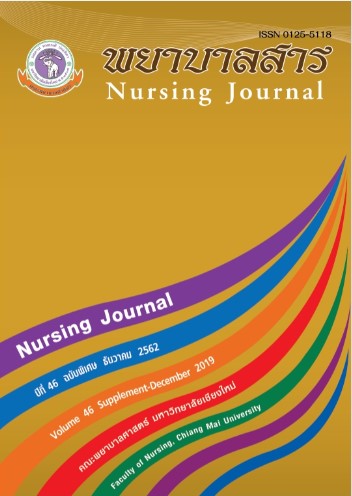Nurses’ Role in Promoting Quality of Life Living Kidney Donors
Keywords:
Kidney Transplantation, Living kidney donors, Nurses role, Quality of lifeAbstract
Nowadays, kidney transplantation is the best treatment option for end stage renal disease. If a new kidney works properly, could replace old one completely so patient could have more long life than other kidney replacement therapies. The number of living donor for kidney transplantation is increasing because the supply of deceased donor kidneys available for transplantation is not enough, living kidney donation provides an involved alternative source of kidney transplantation. However, after donated kidney, living kidney donors still risk to get health impact and mental health impact related to decrease quality of life.Nurses had a crucial role for promoting living donor kidney to improve their quality of life, include 4 dimension such as health and functioning, socioeconomic, psychological/spiritual and family for the purpose that living kidney donors able to continuous living to fullest potential.
References
Center of Organ donate, The Thai Red Cross Society. (2019). Deceased actual organ donor. Retrieved 12 August, 2019 from https://www.organdonate.in.th/assets/files/odc-news.pdf
Ferrans, C. E., & Powers, M. J. (1992). Psychometric assessment of the Quality of Life Index. Res Nurs Health, 15(1), 29-38.
Frade, I. C., Fonseca, I., Dias, L., Henriques, A. C., Martins, L. S., Santos, J., . . . Lopes, A. (2008). Impact assessment in living kidney donation: psychosocial aspects in the donor. Transplant Proc, 40(3), 677-681. doi:10.1016/j.transproceed.2008.02.036
Glotzer, O. S., Singh, T. P., Gallichio, M. H., Conti, D. J., & Siparsky, N. F. (2013). Long-term quality of life after living kidney donation.Transplant Proc, 45(9),3225-3228. doi:10.1016/j.transproceed.2013.05.006
Jacobs, C. L., Gross, C. R., Messersmith, E. E., Hong, B. A., Gillespie, B. W., Hill-Callahan, P., . . . Ibrahim, H. N. (2015). Emotional and Financial Experiences of Kidney Donors over the Past 50 Years: The RELIVE Study. Clin J Am Soc Nephrol, 10(12), 2221-2231.
Jirasirithum, S. (2004). Kidney Transplantation.In:Cochagarn W.(editor). Phaitun Gojaseni’s Textbook of Urology.(2 nd ed.).Bangkok : Beyound enterprize. (In Thai)
Lentine, K. L., Lam, N. N., & Segev, D. L. (2019). Risks of Living Kidney Donation: Current State of Knowledge on Outcomes Important to Donors. Clin J Am Soc Nephrol, 14(4), 597-608. doi:10.2215/cjn.11220918
Lewis, S.L., Bucher,L., Heitkemper, M.M. & Harding, M.M. (2017).Medical surgical nursing : assessment and management of clinical problems. (10 th ed). St.Louis,Missouri: Elsevier.
Lopes, A., Frade, I. C., Teixeira, L., Oliveira, C., Almeida, M., Dias, L., & Henriques, A. C. (2011). Depression and anxiety in living kidney donation: evaluation of donors and recipients. Transplant Proc, 43(1), 131-136. doi:10.1016/j.transproceed.2010.12.028
Lopes, A., Frade, I. C., Teixeira, L., Almeida, M., Dias, L., & Henriques, A. C. (2013). Quality of life assessment in a living donor kidney transplantation program: evaluation of recipients and donors. Transplant Proc, 45(3), 1106-1109. doi:10.1016/j.transproceed.2013.02.100
Messersmith, E. E., Gross, C. R., Beil, C. A., Gillespie, B. W., Jacobs, C., Taler, S. J., . . . Hong, B. A. (2014). Satisfaction With Life Among Living Kidney Donors: A RELIVE Study of Long-Term Donor Outcomes.Transplantation,98(12),1294-1300. doi:10.1097/tp.0000000000000360
Meyer, K. B., Bjork, I. T., Wahl, A. K., Lennerling, A., & Andersen, M. H. (2017). Long-term experiences of Norwegian live kidney donors: qualitative in-depth interviews. BMJ Open, 7(2), e014072. doi:10.1136/bmjopen-2016-014072
Meyer, K., Wahl, A. K., Bjork, I. T., Wisloff, T., Hartmann, A., & Andersen, M. H. (2016). Long-term, self-reported health outcomes in kidney donors. BMC Nephrol, 17(8). doi:10.1186/s12882-016-0221-y
Mjoen, G., Hallan, S., Hartmann, A., Foss, A., Midtvedt, K., Oyen, O., . . . Holdaas, H. (2014). Long-term risks for kidney donors. Kidney Int, 86(1), 162-167. doi:10.1038/ki.2013.460
Morgan, B. R., & Ibrahim, H. N. (2011). Long-term outcomes of kidney donors. Arab Journal of Urology, 9(2), 79-84. doi:https://doi.org/10.1016/j.aju.2011.06.006
Santos, L., Macario, F., Alves, R., Mota, A., & Campos, M. (2010). Risks of living donor nephrectomy. Transplant Proc,42(5),1484-1486. doi:10.1016/j.transproceed.2009.12.078
Sener, A., & Cooper, M. (2008). Live donor nephrectomy for kidney transplantation. Nat Clin Pract Urol, 5(4), 203-210. doi:10.1038/ncpuro1047
Thai transplantation society. (2016). The second Transplantation Care: assessment living donor guideline. Bangkok: Bangkokwachasarn publishing. (In Thai)
Thammanicha, D.(2014). Human Leukocyte Antigen Matching in Kidney Transplantation. J Hematol Transfus, 24(2), 99-101. (In Thai)
The WHOQOL GROUP. (1995). The World Health Organization Quality of Life Assessment (WHOQOL): position paper from the World Health Organization. Social Sciences Medicine, 41 (10): 1403-1409.
Thiel. G.T., Nolte,C,…..Tsinalis D, et al. (2016). Investigating kidney donation as a risk factor for hypertension and microalbuminuria: findings from the Swiss prospective follow-up of living kidney donors. BMJ Open, 6:e010869. doi: 10.1136/bmjopen-2015-010869
Timmerman, L., Laging, M., Timman, R., Zuidema, W. C., Beck, D. K., JN, I. J., . . . Massey, E. K. (2016). The impact of the donors' and recipients' medical complications on living kidney donors' mental health. Transpl Int, 29(5), 589-602. doi:10.1111/tri.12760
Tsai SF, Shu KH, Ho HC, Wu MJ, Cheng CH, Lian JD, et al. (2012). Long-term outcomes of living kidney donors over the past 28 years in a single center in Taiwan. Transplant Proc, 44(1), 39 - 42.
United Nations. (2009). Human Development Report 2009. New York, USA: United Nations
Downloads
Published
How to Cite
Issue
Section
License
บทความที่ได้รับการตีพิมพ์เป็นลิขสิทธิ์ของวารสารพยาบาลสาร
ข้อความที่ปรากฏในบทความแต่ละเรื่องในวารสารวิชาการเล่มนี้เป็นความคิดเห็นส่วนตัวของผู้เขียนแต่ละท่านไม่เกี่ยวข้องกับมหาวิทยาลัยเชียงใหม่ และคณาจารย์ท่านอื่นๆในมหาวิทยาลัยฯ แต่อย่างใด ความรับผิดชอบองค์ประกอบทั้งหมดของบทความแต่ละเรื่องเป็นของผู้เขียนแต่ละท่าน หากมีความผิดพลาดใด ๆ ผู้เขียนแต่ละท่านจะรับผิดชอบบทความของตนเองแต่ผู้เดียว






